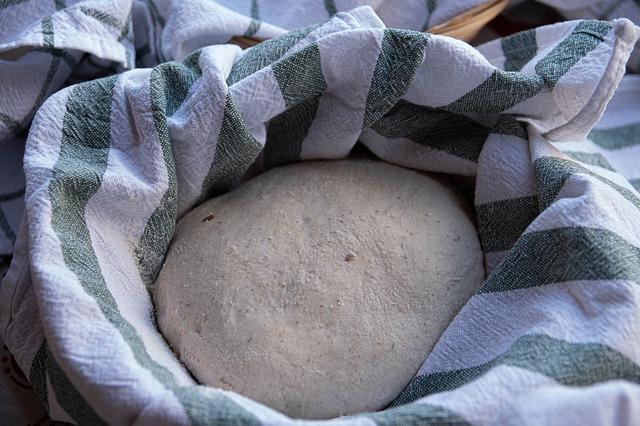Table of Contents
- Exploring the Essential Role of Yeast Strands in Kombucha Fermentation
- Unveiling the Varieties and Functions of Yeast Strains in Your Brew
- Balancing Yeast and Bacteria: Key to Ideal Kombucha Flavor
- Troubleshooting Common Yeast Issues for a Consistent Kombucha Experience
- Selecting the Right Yeast Strand: Enhancing Fermentation and Aroma
- Q&A
- Insights and Conclusions


Exploring the Essential Role of Yeast Strands in Kombucha Fermentation
At the heart of kombucha’s magical transformation from a plain sugary tea to a tangy, effervescent beverage is the dynamic activity of yeast strands. These microscopic fungi initiate the fermentation process by breaking down sugars into alcohol and carbon dioxide, setting the stage for bacterial action. Different strains of yeast contribute unique flavors and textures to kombucha, making each batch a singular experience. With their ability to vary by the type of tea used, temperature, and fermentation time, these strands truly define the character and quality of the final brew.
Beyond flavor, yeast strands play a vital role in creating the distinct balance of acids and nutrients in kombucha. These acids, including gluconic and acetic acids, are products of the microbial symbiosis between yeast and bacteria, contributing to the probiotic benefits and the drink’s preserved quality. While individual stains such as Saccharomyces and Zygosaccharomyces are most commonly found, the diversity within the culture is what imparts the depth of flavor and nutrient profile. Understanding this diversity can help brewers manipulate the fermentation environment to optimize health benefits and flavor intensity.
| Yeast Strain | Characteristics | Impact on Kombucha |
|---|---|---|
| Saccharomyces | Alcohol and carbonation production | Adds fizz and initial alcohol content |
| Zygosaccharomyces | High sugar tolerance | Vital for flavor depth and preservation |
The intricate dance of these yeast organisms with bacteria results in a drink that’s not only delightful to taste but also nourishing. It’s fascinating how yeast strands adjust to elements like oxygen exposure, impacting the overall acidity levels and potential sweetness. By tweaking these conditions, brewers can craft kombucha that varies from the traditional sour-tart to uniquely sweet and mild. The exploratory journey through the world of yeast in kombucha fermentation is as varied and customizable as the drink itself, offering endless possibilities for innovation and enjoyment.


Unveiling the Varieties and Functions of Yeast Strains in Your Brew
Kombucha’s distinctive tang and effervescence owe much to the fascinating world of yeast. Within this symbiotic culture of bacteria and yeast (SCOBY), a variety of yeast strains contribute to the unique processes that transform sweetened tea into this probiotic-rich beverage. Among the yeast strains, Saccharomyces cerevisiae and Brettanomyces bruxellensis stand out as major players. While Saccharomyces cerevisiae operates to ferment the sugars into alcohol, Brettanomyces bruxellensis continues the fermentation, adding complexity through its ability to break down a wider array of substrates. These yeast strains define the character and funkiness of kombucha.
The functionality of yeast involves more than just fermentation. Each strain brings specific traits to the table, influencing everything from flavor nuances to fizziness. For instance, Zygosaccharomyces bailii is known for its resistance to acidic environments, making it particularly effective in reinforcing kombucha’s tartness without falling prey to the acid itself. The yeast provides several key functions:
- Carbon Dioxide Production: Ensures that delightful fizz in every sip.
- Alcohol Production: An essential intermediary in developing that distinct tangy flavor.
- Flavor Layering: Different strains contribute subtle notes, ranging from fruity to earthy.
Understanding the attributes of various yeast strains can empower brewers to refine their craft, creating kombucha with distinctive flavor profiles. Experimenting with different yeast combinations can unlock new taste dimensions. Below is a simple guide showcasing the influence of select yeast strains on kombucha’s characteristics:
| Yeast Strain | Main Function | Flavor Contribution |
|---|---|---|
| Saccharomyces cerevisiae | Sugar Fermentation | Mild, fruity |
| Brettanomyces bruxellensis | Complex Fermentation | Funky, earthy |
| Zygosaccharomyces bailii | Acid-Resistance | Intense, tart |


Balancing Yeast and Bacteria: Key to Ideal Kombucha Flavor
In crafting the perfect kombucha, the harmony between yeast and bacteria is paramount. Yeast, a type of fungi, begins the fermentation process by breaking down sugars, producing alcohol and carbon dioxide as byproducts. Bacteria, particularly Acetobacter, then oxidizes the alcohol, creating the tangy acetic acid flavor kombucha is known for. Too much yeast can result in an overly alcoholic brew, while dominant bacteria can lead to excessive sourness. Balancing these microorganisms means cultivating the symbiotic culture of bacteria and yeast (SCOBY) in a way that each thrives without overwhelming the other.
Temperature plays a crucial role in this balance. Warmer environments tend to favor yeast activity, accelerating fermentation and boosting carbonation, but may risk overly sweet or alcoholic results if unchecked. Conversely, cooler temperatures slow things down, allowing bacteria ample time to produce acidity but potentially compromising the beverage’s fizzy character. Consistent monitoring and adjusting of the brewing temperature can help maintain the desired equilibrium between yeast and bacteria. Brewers often find the sweet spot around 75°F to 85°F (24°C to 29°C).
- pH levels: A balanced pH ranges around 3.2 to 3.5.
- Sugar content: Initial sugar plays into yeast activity but should diminish to avoid sweetness.
- Smell: A balance should bring notes both tangy and sweet.
| Factor | Optimal Range |
|---|---|
| pH Level | 3.2 – 3.5 |
| Temperature | 75°F – 85°F |
| Fermentation Time | 7 – 14 days |
Maintaining this equilibrium also involves keen attention to fermentation duration. Typically, a brewing period of 7 to 14 days allows the flavors to develop fully while keeping both yeast and bacteria happy. Within this timeframe, regular tastings can help brewers pinpoint the exact moment when their kombucha reaches its peak flavor, ensuring neither the yeast nor the bacteria overshadows the other. Mastering this art transforms a simple beverage into a nuanced symphony of taste, inviting enthusiasts to savor the multifaceted character of kombucha.


Troubleshooting Common Yeast Issues for a Consistent Kombucha Experience
Troubleshooting issues with yeast in your kombucha brew can make all the difference in achieving that perfect balance of flavor and fizz. One common problem might be an excess of yeast, which can leave your kombucha with a cloudy appearance or an overly yeasty taste. To address this, consider maintaining a consistent temperature in your brewing environment, ideally between 68°F and 78°F (20°C-25°C). This helps to prevent yeast from becoming overly active. Adding a bit of white or apple cider vinegar can also help balance the pH levels, creating a more harmonious environment for your yeast and bacteria.
Another frequent issue is sluggish fermentation, where yeast does not appear to be effectively converting sugars, leading to a lack of carbonation and sweetness that’s expected in a well-fermented batch. Check the vitality of your SCOBY (Symbiotic Culture of Bacteria and Yeast); if it’s old or damaged, consider introducing a fresh, robust SCOBY to energize the fermentation process. Ensure that your brewing jar is properly sealed, as any gaps can lead to reduced yeast activity. Regularly stirring the brew can prevent dead yeast cells from settling at the bottom, particularly if you’re using loose tea leaves.
If you’re encountering excessive sediment or “floaties” in your drink, this may be caused by improper yeast flocculation. To combat this, perform regular maintenance by cleaning your brewing vessel and SCOBY every few batches. You might also find it helpful to adjust the sugar levels, as too much sugar can overwhelm the yeast, while too little can starve it. See the table below for a quick reference on common yeast issues and their solutions:
| Yeast Issue | Solution |
|---|---|
| Excess Yeast | Stabilize Temperature, Add Vinegar |
| Sluggish Fermentation | Introduce Fresh SCOBY, Seal Jar |
| Excessive Sediment | Clean Vessel, Adjust Sugar Levels |


Selecting the Right Yeast Strand: Enhancing Fermentation and Aroma
When diving into the world of kombucha, understanding the significance of different yeast varieties can be transformative. Yeast not only drives fermentation but also contributes to the drink’s distinct bouquet of aromas and flavors. Brettanomyces and Saccharomyces are two popular yeast strands known for their robust ability to metabolize sugars, each imparting unique character to the final brew. Brettanomyces is often celebrated for its funky, fruity notes, making it a favorite among artisan brewers. In contrast, Saccharomyces yields a cleaner and more controlled flavor profile, perfect for those aiming for a more traditional taste.
Choosing the right yeast involves more than flavor consideration. Fermentation speed, alcohol tolerance, and temperature resilience are key factors. Brettanomyces tends to have a slower fermentation process, which might be ideal for those willing to wait for deeper complexities to develop. On the other hand, the speedy Saccharomyces strand allows for quicker production cycles. Here’s a quick comparison to help guide your choice:
| Yeast Strand | Fermentation Speed | Aroma Profile |
|---|---|---|
| Brettanomyces | Slow | Fruity, Funky |
| Saccharomyces | Fast | Clean, Traditional |
For brewers, the journey of discovering the perfect yeast strand for kombucha is both an art and a science. Many opt to experiment with a mixture of strains, creating a symbiotic culture of bacteria and yeast (SCOBY) that holds secrets to both taste and health benefits. While a single type might offer consistency, blending can unveil myriad hidden flavors. Engaging with kombucha communities can provide insights into successful experimentation and strain selection, nurturing both your creativity and palate expansion. Remember, each strand brings a world of potential awaiting exploration in every bottle of kombucha you create.
